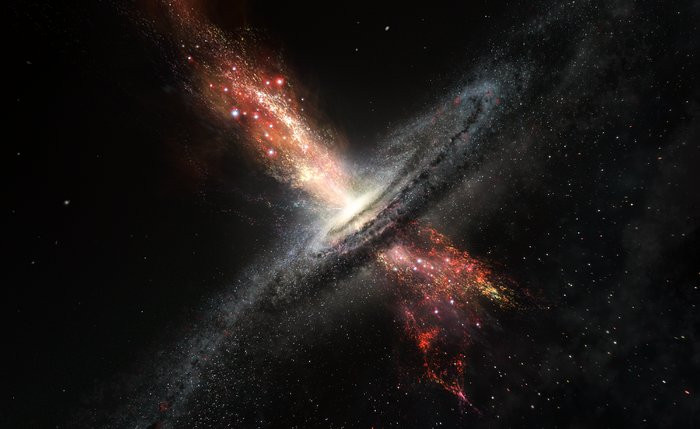Bright stars form in super massive black hole blasts
Scientists have seen evidence of stars forming in extreme environments.
Stars are forming within the outflows of material blasted out from supermassive black holes at the cores of galaxies, scientists have discovered. This is the first time they are able to find solid evidence of star formation in this kind of extreme environments.
This is a major discovery for astronomers because it could help them answer a number of fundamental questions of astrophysics, including how some galaxies obtain their shapes, how intergalactic space becomes enriched with heavy elements, or where unexplained cosmic infrared background radiation comes from.
The scientists, led by Roberto Maiolino from the University of Cambridge, used ESO's Very Large Telescope (VLT) – the world's most advanced optical instrument – to conduct their investigations. They studied the collision of two galaxies located 600 million light-years from Earth and known collectively as IRAS F23128-5919.
Supermassive black holes can be found in the cores of most galaxies, and when they gobble up matter they also heat the surrounding gas and expel it from the host galaxy in powerful, dense winds.
Here, the scientists specifically looked at such galactic outflows blasted out of the supermassive black hole at the heart of the pair's southern galaxy. They found the first clear evidence that stars can form within these material outflows.
"Astronomers have thought for a while that conditions within these outflows could be right for star formation, but no one has seen it actually happening as it's a very difficult observation," Maiolino commented. "Our results are exciting because they show unambiguously that stars are being created inside these outflows."
Proofs of the young stars
The scientists were able to identify these young stars within the material outflows by using two of the VLT spectroscopic instruments, MUSE and X-shooter.
Radiation from young stars is known to cause nearby gas clouds to glow in a particular way. The team used X-shooter to rule out other possible causes of this illumination, including gas shocks or the active nucleus of the galaxy.

The scientists then directly detected an infant stellar population in the material outflow. These stars are thought to be less than a few tens of millions of years old and are thought to be hotter and brighter than stars formed in less extreme environments.
To gather more evidence of the phenomenon, the astronomers determined the motion and velocity of these young stars. The light from most of the region's stars indicates that they are travelling at very large velocities away from the galaxy centre – which is what would be expected of objects caught in a stream of fast-moving material blasted off from black holes.
"If star formation is really occurring in most galactic outflows, as some theories predict, then this would provide a completely new scenario for our understanding of galaxy evolution", Maiolino concluded.
© Copyright IBTimes 2025. All rights reserved.






















